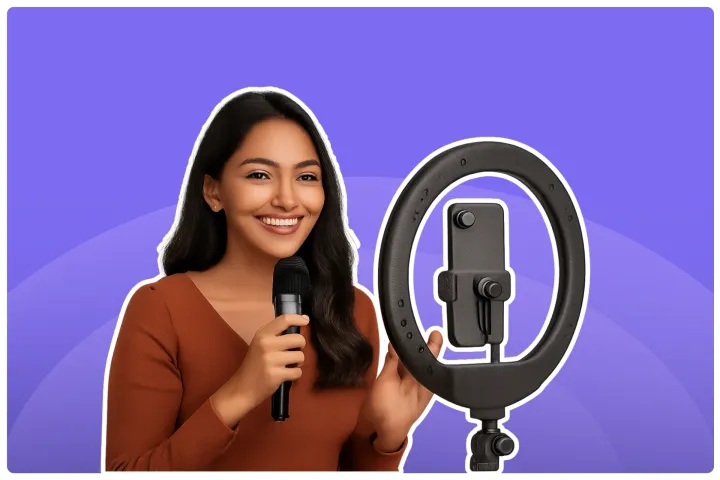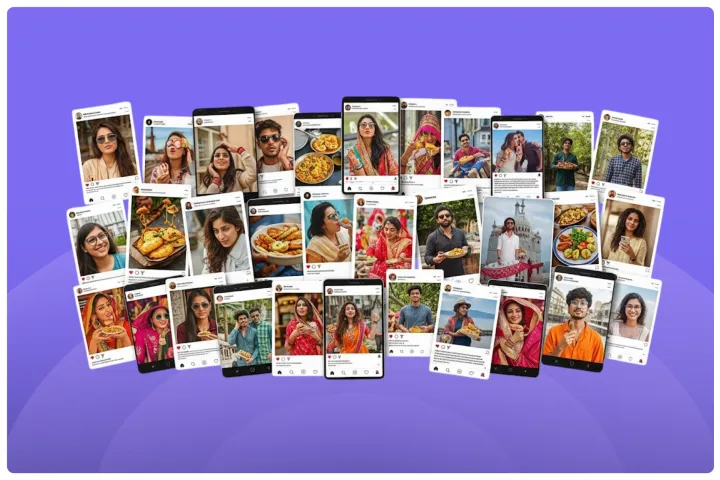User Generated Content Legal Issues: What To Do?
User-generated content can be a goldmine, but it comes with legal risks. Find out how to manage these issues effectively and keep your content safe!

User-Generated Content (UGC) is like having a massive team of cheerleaders creating amazing stuff for your brand, but just like any powerful tool, you've got to know how to use it right. This guide will walk you through everything – the good, the potentially tricky, and how to make UGC your brand’s superpower, especially keeping our Indian businesses in mind!
What is User Generated Content?
Alright, let's get down to basics. What exactly is this "User-Generated Content" or UGC that everyone's buzzing about? 🤔
Think of it this way: User-Generated Content is any kind of content – text, videos, photos, reviews, even a cool dance reel featuring your product – that’s created by everyday people, your customers, or your fans, rather than by your brand itself. They’re not on your payroll; they’re just genuinely sharing their experiences, thoughts, or creativity related to your brand.
Imagine this:
- Priya from Pune posts a stunning Instagram photo sipping your brand's new cold coffee, tagging you. That's UGC! 📸
- Rajesh leaves a detailed, glowing review on your e-commerce site about how your software saved him hours of work. That’s UGC! ⭐⭐⭐⭐⭐
- A group of college students in Bengaluru creates a hilarious TikTok/Instagram Reel showing off their outfits from your clothing store. That’s UGC!💃🕺
- Someone writes a blog post about their fantastic stay at your boutique hotel in Goa. You guessed it – UGC! 📝
Brands can then spot this authentic goldmine and, with permission (super important, we’ll get to that!), use this content in their own marketing. It’s like your audience becoming your extended marketing team, creating content that’s often seen as more trustworthy and relatable than traditional ads.
Why is UGC such a big deal?
1) Authenticity is King (and Queen!): People trust people. Nielsen reports consistently show that consumers trust recommendations from people they know (even online acquaintances) far more than they trust direct brand advertising. A 2023 Stackla report found that 79% of people say UGC highly impacts their purchasing decisions. This is a huge jump and shows the growing power of authentic voices!
2) Boosts Trust and Credibility: When potential customers see real people loving your product or service, it builds a strong sense of trust. It’s social proof in action. It’s like seeing a restaurant buzzing with happy customers – you’re more likely to want to eat there, right?
3) Increases Engagement: UGC often sparks conversations and encourages more interaction. When you feature a customer's post, they feel seen and appreciated, and their followers might jump into the conversation too! It’s a community-building powerhouse.
4) Cost-Effective Content Goldmine: Let’s be real, creating high-quality marketing content consistently can be expensive and time-consuming. UGC provides a steady stream of creative and diverse content, often at a fraction of the cost of professional shoots. Think of all the rupees (₹) you could save!
5) Provides Valuable Insights: The UGC your audience creates gives you a direct window into how they perceive and use your products. You might discover new use cases or get honest feedback that can help you improve.
For example, let’s say you’re a snack brand. You might run a campaign asking users to share their favorite #MySnackTimeCreation. The variety of recipes, photos, and videos you receive not only gives you marketing material but also shows you how creatively people are using your snacks!
UGC isn’t just a fleeting trend; it’s a fundamental shift in how brands can connect with their audience. It’s about handing the mic over to your customers and letting their authentic voices shine. And trust me, their voices can be incredibly powerful for your brand’s growth. So, are you ready to tap into this power? Let’s explore how to do it safely and effectively!
User Generated Content Legal Issues
Okay, so we've established that UGC is pretty awesome. ✨ It’s authentic, engaging, and can give your brand a serious boost. But, (and it’s an important ‘but’), before you rush off to repost every cool photo or glowing review you find, we need to chat about the legal side of things. Think of it like driving a fancy new car – you need to know the rules of the road to enjoy the ride smoothly and avoid any bumps (or fines!).
Ignoring the legal aspects of UGC can land your brand in some hot water, from hefty fines to a damaged reputation. No one wants that, right? So, let’s break down the common legal pitfalls you need to be aware of.
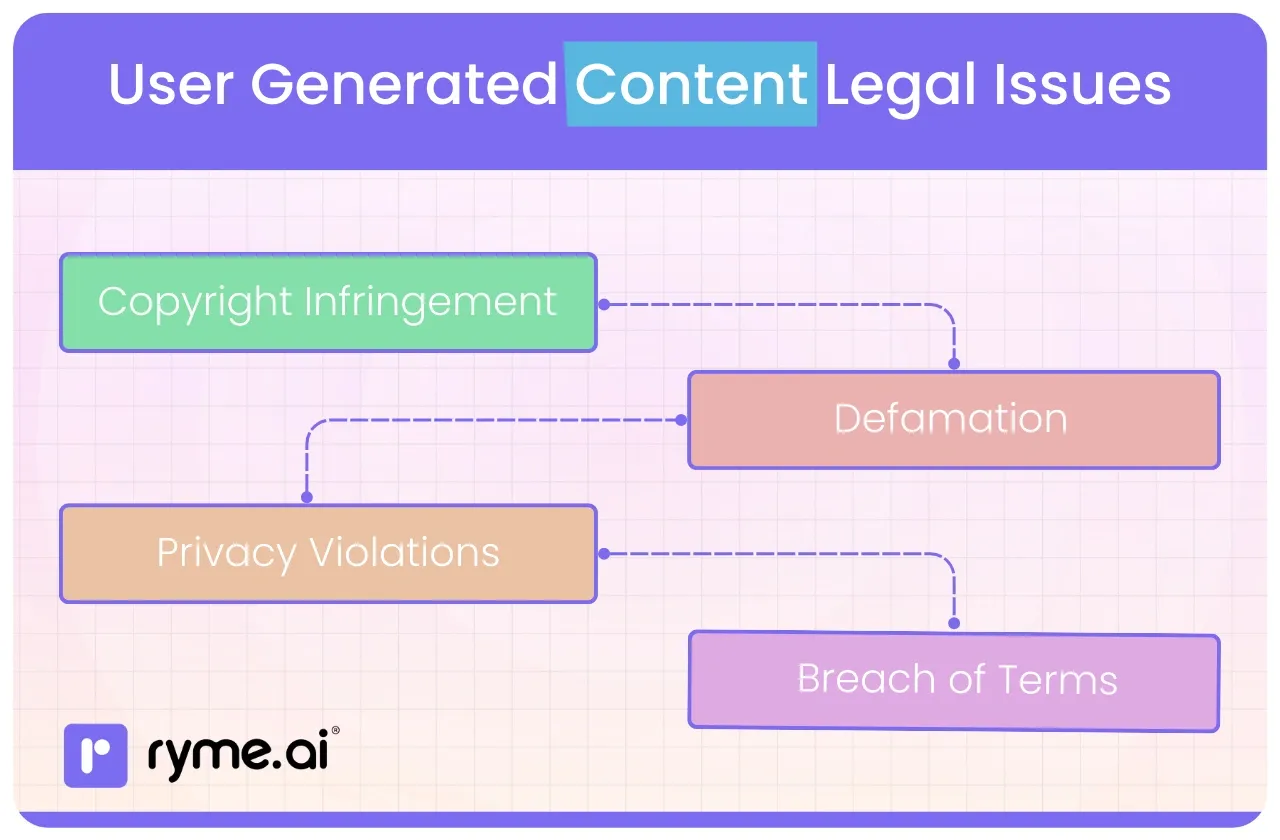
1) Copyright Infringement: "Oops, I thought I could just use that!"
This is probably the biggest and most common legal hiccup with UGC.
What it is: Copyright law protects original works of authorship – photos, videos, music, written text, you name it. The moment someone creates something original, they automatically own the copyright to it. Using their content (like that cool photo a customer took of your product) for your brand’s commercial purposes without their explicit permission is copyright infringement.
Why it matters for brands: Let's say a customer, Sneha, posts a beautiful, professionally-shot looking photo of her wearing your designer lehenga at a wedding. You think, "Wow, this is perfect for our Instagram feed!" and repost it. If Sneha didn't give you permission to use it for your marketing, she could legally claim copyright infringement. This could lead to you having to take the content down, pay her a licensing fee, or even face a lawsuit for damages. Ouch! 😬
The common mistake: Many brands assume that if a user tags them or uses their brand hashtag, it’s an implied permission to use the content. This is a risky assumption! While tagging can sometimes be part of a clear set of terms for a specific campaign (which we'll discuss in best practices), it’s not a blanket green light.
Think about it: The creator invested their time, skill, and maybe even money (for equipment or location) to create that content. They deserve to control how it's used, especially if a brand stands to profit from it.
Recent Data Point: A 2023 survey by a legal tech firm indicated that nearly 40% of small businesses that used UGC without clear permissions faced some form of dispute, ranging from takedown requests to legal notices. This highlights the reality of the risk.
2) Defamation: "They said what now?"
This one is about protecting reputations.
What it is: Defamation is when someone communicates a false statement about another person or entity (like another business) that harms their reputation. If it's written, it's called libel. If it's spoken, it's slander.
Why it matters for brands: Imagine a user posts a comment on your social media page making a false and damaging claim about a competitor, or even another individual. If your brand then shares, retweets, or highlights that comment, you could be seen as endorsing or republishing that defamatory statement. This could make your brand liable for defamation, even if you didn't write the original comment.
Example: A customer posts on your Facebook page, "Don't buy from Brand X, their products are fake and made with child labor!" If this is untrue and you amplify this post (e.g., by featuring it as "feedback we've received"), your brand could be sued by Brand X for defamation.
The key here: Truth is generally a defense against defamation. But are you, as a brand, in a position to verify the absolute truth of every piece of UGC you share that makes claims about others? Probably not. So, it's best to be cautious.
3) Privacy Violations: "Is it okay to share this much?"
People have a right to their privacy, and as brands, we must respect that.
What it is: Privacy violations occur when you share someone's personal or private information without their consent, in a way that they wouldn't reasonably expect. This can include things like their full name (if not already public in that context), their exact location, images of them in a private setting, or any other sensitive personal data.
Why it matters for brands: Suppose a customer posts a photo from inside their home, enjoying your product, but in the background, there's personal information visible (like a child's photo on the fridge, or a personal letter on a table). If you repost this without them realizing that private detail is visible and without explicit consent covering that, it could be a privacy breach. Similarly, if a user shares a story with you via DM, and you screenshot and publicly share it without permission, that's a problem.
Data Protection Laws: Laws like the GDPR in Europe and India's Digital Personal Data Protection Act (DPDPA), 2023 (and the earlier IT Rules, 2011) are very clear about the need for consent when handling personal data. User-generated content can often contain personal data. Sharing a photo of an identifiable person is processing their personal data.
Example: A customer shares a picture of themselves using your fitness app, and the screenshot includes their full name, email, and recent locations from the app's GPS tracking. Sharing this broadly would be a serious privacy violation.
4) Breach of Terms: "But the platform allowed it..." (Not always!)
Every social media platform (Instagram, Facebook, X, YouTube, etc.) has its own Terms of Service (ToS) or Community Guidelines.
What it is: These terms outline what users and brands can and cannot do on the platform. This includes rules about running contests, promotions, how content can be shared, and intellectual property.
Why it matters for brands: If you run a UGC campaign or use UGC in a way that violates the platform's rules, you could face penalties from the platform itself. This might include your content being removed, your account being suspended, or even a permanent ban. 😱
Example: Instagram has specific rules for promotions. If you run a UGC contest asking people to tag themselves in photos they aren't actually in, or misrepresent sponsorships, you're breaching Instagram's terms.
Don't forget your own terms: If you run a UGC contest, you should have your own clear terms and conditions for participation. If a user submits content, and you then use it in a way that breaches your own stated T&Cs for that campaign, that can also lead to disputes.
Navigating these legal waters might seem a bit daunting, but don't worry! Understanding the risks is the first step to avoiding them. The good news is that with some smart practices, you can harness the power of UGC while keeping your brand safe and sound. We'll cover those best practices next, so you can confidently and ethically engage with your audience's fantastic creations!
Best Practices for Brands Using UGC
Alright, we've looked at the potential legal speed bumps. Now for the fun part: how to navigate them like a pro and make your UGC strategy a resounding success! 🎉 Think of these best practices as your friendly GPS, guiding you to build a UGC program that’s not only effective but also respectful and legally sound. Your customers will love you for it, and your legal team (if you have one!) will breathe a sigh of relief.
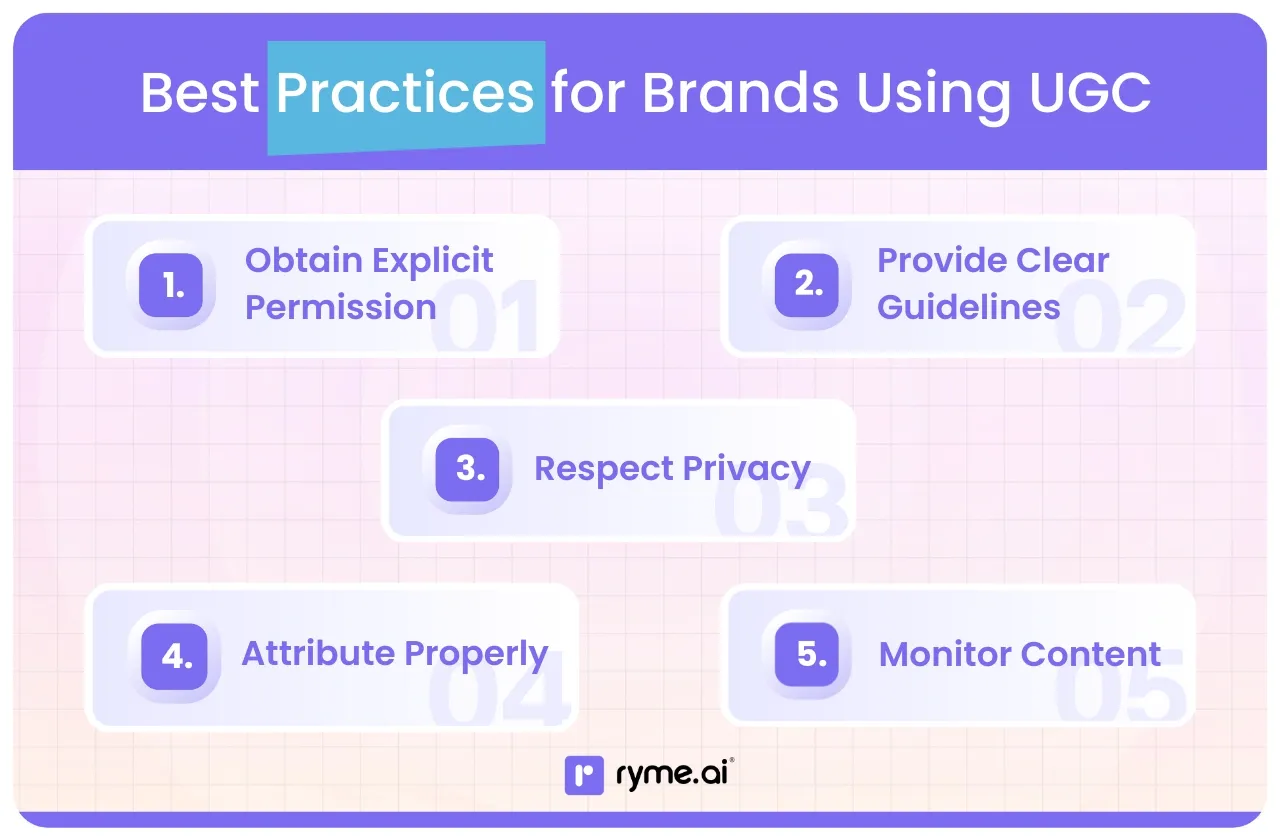
1) Obtain Explicit Permission: Your Golden Rule! 📜
This is THE most important best practice. Seriously, if you take away only one thing, let it be this.
What it means: Before you use any piece of UGC for your brand’s marketing purposes (whether it's on your social media, website, email newsletter, or even print ads), you need to get clear, unambiguous, and preferably written permission from the original creator.
Why it's crucial: This directly addresses the biggest legal risk: copyright infringement. Having explicit permission means the creator has given you the right to use their content. It protects you from legal claims and shows respect for their work.
How to do it effectively:
- Direct Outreach: The most straightforward way is to reach out directly. If you see a post you love on Instagram, send the user a Direct Message (DM) or leave a public comment asking for permission.
- Example DM/Comment Template: "Hey [User's Name/Handle]! We absolutely LOVE this [photo/video/post] you shared featuring our [product/service]! 😍 Would you be open to us sharing it on our official [platform, e.g., Instagram feed, website homepage]? We'll be sure to give you full credit, of course! If you're happy for us to do so, please reply to this message with #Yes[YourBrandName]." Make sure to specify where and how you plan to use their content. Using it on your social feed is different from using it in a paid TV ad. Be clear about the scope.
- Use a Branded Hashtag with Clear Terms: For specific campaigns, you can ask users to submit content using a unique branded hashtag (e.g., #[YourBrandName]Contest, #[YourBrandName]Adventures).
- Crucial Caveat: If you go this route, you must have very clear Terms and Conditions (T&Cs) for the campaign, easily accessible (e.g., link in bio, on your contest landing page). These T&Cs should explicitly state that by using the hashtag, users agree that their content may be used by your brand for marketing purposes (and specify those purposes). Even then, for high-value content or wider usage, getting individual confirmation is still a gold standard.
- Rights Management Platforms: Some tools help streamline the process of requesting and managing UGC rights. We’ll touch on these later.
- Keep Records: Save screenshots of your permission requests and the user's affirmative responses. This documentation is your proof if any questions arise later.
Screenshot Example (Conceptual):
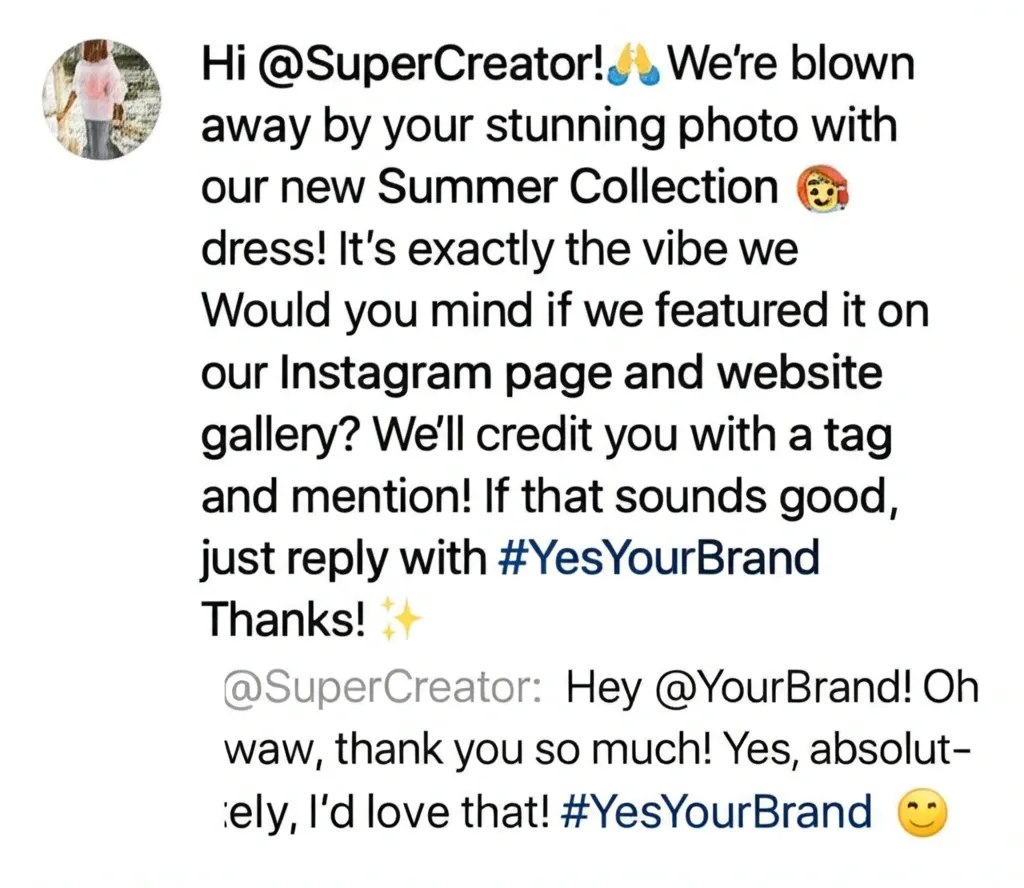
This is clear, friendly, and documented!
2) Provide Clear Guidelines: Set Expectations from the Start 📝
If you're actively soliciting UGC, especially for a contest or campaign, make it easy for users to create what you're looking for and ensure it aligns with your brand and legal standards.
What it means: Establish and clearly communicate the rules, themes, and any do's and don'ts for content submissions.
Why it's important:
- Relevance: You get content that actually fits your campaign goals and brand aesthetic.
- Quality: You can guide users on the kind of quality you expect (though UGC's charm is often its raw authenticity!).
- Legal Compliance: You can proactively steer users away from creating content that might be problematic (e.g., "Please don't include other brands' logos," or "Ensure you have permission from anyone visible in your photo").
What to include in your guidelines:
- Theme/Topic: What should the content be about? (e.g., "Show us your favorite way to enjoy our coffee at home! ☕")
- Content Format: Photos, videos, text? Any specific dimensions or length?
- Key Elements: Should your product be visible? Is there a particular mood or style?
- Hashtags: The official campaign hashtag and any other relevant ones.
- Do's: (e.g., "Be creative! Show your personality! Ensure good lighting!")
- Don'ts: (e.g., "No offensive material, no visible competitor logos, no content you don't own the rights to.")
- Eligibility: Age restrictions, geographic limitations, etc.
- Deadline: If it's for a contest or specific campaign.
- How to Submit: Via hashtag, direct upload, email?
- Link to full T&Cs: Always!
Example of a Guideline Snippet for an Indian Travel Gear Brand:
"Share your most epic #IncredibleIndiaAdventure with our TrekReady Backpack! 🎒
We're looking for:
- ✔️ Photos or short video clips (under 60 secs)
- ✔️ Your TrekReady Backpack must be visible!
- ✔️ Scenic outdoor locations in India
- ✔️ You, having an adventure! (Make sure anyone else in the photo is okay with it being shared!)
- ✖️ Please avoid: Blurry shots, content with visible logos of other travel gear brands, or any unsafe activities.
Use #IncredibleIndiaAdventure & #MyTrekReady to enter! Contest ends Oct 31st. Link in bio for full T&Cs."
3) Respect Privacy: Handle with Care ❤️
This echoes our earlier point on privacy violations but focuses on proactive best practices.
What it means: Be super mindful of any personal information that might be in the UGC. Avoid sharing anything that could be considered sensitive or private without explicit consent, even if it's publicly posted.
Why it's crucial: Trust is fragile. If users feel you're careless with their (or others') personal information, you'll damage your brand's reputation. Plus, data privacy laws (like GDPR and India's DPDPA, 2023) carry hefty penalties. Major publications and digital watchdogs, like The Guardian often highlight the paramount importance of robust data privacy practices in the digital age, and brands should take this to heart.
How to do it:
- Review carefully: Before reposting, scrutinize the content for any potentially sensitive details (e.g., kids in the background, visible addresses, full names on documents, license plates).
- Ask if unsure: If a photo features other identifiable people apart from the creator, it's best to confirm that the creator got their permission too. Your permission request can include a line like, "Please also confirm you have permission from everyone identifiable in the photo/video."
- Anonymize if necessary (with permission): Sometimes, a user might share a great story but prefer to remain anonymous or have certain details obscured. Respect that.
- Don't scrape data: Avoid collecting more personal data from users than you absolutely need for the UGC interaction.
4) Attribute Properly: Give Credit Where Credit is Due! 🌟
This is basic courtesy and a non-negotiable part of ethical UGC use.
What it means: Always, always, always give clear and visible credit to the original creator of the content.
Why it's important:
- Respect & Recognition: It acknowledges their creativity and effort. Users appreciate being recognized!
- Transparency: It shows your audience that the content is from a real user, boosting its authenticity.
- Often a Condition: Many users will only grant permission if they are properly credited.
- Drives Traffic to Creator: It can help the creator gain more visibility and followers too – a win-win!
How to do it:
- Tagging: On platforms like Instagram, tag the creator’s handle directly in the photo/video and mention them in the caption (e.g., "📸 Amazing shot by @[UserHandle]!" or "Love this look from @[UserHandle]!").
- Clear Captions: For websites or blogs, state their name or username clearly alongside the content.
- Ask for their preference: Sometimes users have a specific way they’d like to be credited (e.g., their photography business name instead of their personal handle). It doesn't hurt to ask.
Example of Good Attribution on an Instagram Post:

RestaurantBrandHandle: Weekend vibes done right! 🍽️😋 We're drooling over this incredible flatlay shared by the talented @FoodieAdventuresInMumbai! Thanks for capturing the deliciousness so perfectly!
Want to be featured? Tag us and use #OurRestaurantDelights!
#CustomerLove #FoodPhotography #MumbaiFoodies #WeekendFeast
5) Monitor Content: Keep an Eye Out 👀
Once you've encouraged UGC or started featuring it, your job isn't done. Ongoing monitoring is key.
What it means: Regularly review the UGC being submitted under your campaign hashtags, content posted on your pages, and the UGC you've already featured.
Why it's important:
- Legal Compliance: To catch any content that might be infringing, defamatory, or violate privacy before it becomes a bigger issue, or if you've inadvertently shared something problematic.
- Brand Safety: Ensure the content aligns with your brand values and isn't offensive or inappropriate. Trolls or inappropriate content can sometimes latch onto popular hashtags.
- Engagement: It’s also an opportunity to engage with new UGC, thank creators, and spot emerging trends.
How to do it:
- Manual Checks: Dedicate time for someone on your team to regularly scan hashtags and mentions.
- Moderation Tools: For larger volumes of UGC, consider using content moderation tools (more on this later!) that can help filter or flag potentially problematic content using AI.
- Stay Updated on Your Featured Content: Sometimes, a user might delete their original post or change their mind about permission. While your initial permission is key, if a user requests removal of their content you've featured, it's generally good practice to comply promptly to maintain goodwill.
By consistently applying these best practices, you're not just protecting your brand legally; you're building a stronger, more authentic, and more respectful relationship with your customers. They'll feel valued, and your brand will shine with genuine, user-driven appeal. Think of it as laying a strong foundation for a beautiful UGC house! 🏠💖
Legal Frameworks Governing User Generated Content
Now that you're a pro at the best practices for handling UGC, it's helpful to have a general understanding of some of the key laws and regulations that shape how UGC is treated in different parts of the world. You don't need to become a lawyer overnight (phew!😅), but knowing these frameworks will give you context and reinforce why those best practices are so important. We'll look at the US, EU, and India, as they have influential regulations that often set trends.
United States (US) 🇺🇸
The US has a couple of landmark pieces of legislation that significantly impact the online world, including UGC, mostly from the perspective of the platforms hosting it.
Section 230 of the Communications Decency Act (CDA)
What it is (in simple terms): Often called the "26 words that created the internet," Section 230 generally provides immunity to online platforms (like social media sites, forums, review sites) from liability for most content posted by their users. So, if a user posts something defamatory on Facebook, Facebook itself usually isn't held liable for that user's speech.
Why it matters for your brand using UGC:
Platform Protection, Not Yours (Directly for Misuse): While Section 230 protects the platform hosting the UGC, it doesn't protect your brand if you misuse UGC. For example, if you take a user's copyrighted photo from Instagram and use it in your ad without permission, Section 230 won't shield you from a copyright infringement claim by the user. Instagram (the platform) is generally protected, but you (the brand reposting) are not.
Content Moderation Choices: Section 230 also gives platforms the ability to moderate content (e.g., remove posts that violate their terms) without becoming liable for everything else on their site. This is why platforms can have community guidelines.
Key Takeaway for Brands: Don't assume platform immunity extends to your brand's specific actions with UGC. Your responsibility for obtaining rights and permissions remains.
Digital Millennium Copyright Act (DMCA)
What it is: The DMCA is a comprehensive US copyright law. A key part of it is the "safe harbor" provision for online service providers (OSPs), which includes platforms that host UGC.
How "Safe Harbor" Works: To qualify for safe harbor, OSPs must implement a "notice-and-takedown" system. This means if a copyright holder (like a photographer) finds their work being used without permission on a platform, they can send a DMCA takedown notice to the platform. The platform must then promptly remove the infringing content to maintain its safe harbor protection (meaning it won't be liable for the infringement itself).
Why it matters for your brand using UGC:
If Your Copyrighted Content is Misused by Users: If a user posts your brand's copyrighted material (e.g., your logo, your ad creative) without permission, you can use the DMCA takedown process to get it removed from the platform.
If You're Accused of Infringement: If you use a piece of UGC without proper rights, the original creator could send a DMCA takedown notice to the platform where you've posted it (e.g., your Instagram page). The platform would likely remove your post. This highlights the importance of getting permission before posting.
Understanding Platform Actions: It helps you understand why platforms act quickly to remove content when they receive a valid DMCA notice.
Key Takeaway for Brands: Respect copyright. The DMCA provides a mechanism for copyright holders to protect their work online. Ensure you have the rights before you post UGC to avoid DMCA notices against your brand.
European Union (EU) 🇪🇺
The EU has a strong focus on data protection and regulating online services, which directly impacts UGC.
General Data Protection Regulation (GDPR)
What it is: The GDPR is a comprehensive data privacy law that sets strict rules for the collection, processing, and storage of personal data of individuals within the EU. "Personal data" is broadly defined and can include names, photos, online identifiers, etc. – basically anything that can identify a person.
Why it matters for your brand using UGC:
UGC as Personal Data: A lot of UGC involves personal data. A photo of a user, their name, their online handle – these can all be personal data. If the user is in the EU (even if your brand isn't), GDPR rules can apply.
Lawful Basis for Processing: Under GDPR, you need a "lawful basis" to process personal data. For using UGC featuring identifiable individuals, this often means consent. The consent must be freely given, specific, informed, and unambiguous. This ties back directly to our best practice of getting explicit permission!
User Rights: GDPR grants individuals strong rights over their data, including the right to access their data, rectify it, erase it (the "right to be forgotten"), and withdraw consent. If a user gave you permission to use their photo and later withdraws consent, you generally need to stop using it.
Key Takeaway for Brands: If your UGC involves identifiable individuals from the EU, you must comply with GDPR. This means robust consent mechanisms, clear privacy notices, and respecting user rights over their data.
Digital Services Act (DSA) & Digital Markets Act (DMA) (More recent than the E-Commerce Directive, and more impactful now)
What they are: The DSA and DMA are newer EU regulations aimed at creating a safer and fairer online environment. The DSA focuses on how online platforms (including social media) moderate content, handle illegal content, and increase transparency. The DMA targets large "gatekeeper" online platforms to ensure fair competition.
Why they matter for your brand using UGC:
Platform Responsibilities: The DSA places more obligations on platforms regarding content moderation, including taking down illegal content (which could include certain types of harmful UGC or UGC that infringes rights). While this is more about platform governance, it creates an environment where problematic content is more likely to be flagged and removed.
Transparency: Increased transparency requirements for platforms can give more insight into how content is treated, which can indirectly affect how brands interact with UGC on those platforms.
Key Takeaway for Brands: While these primarily regulate platforms, they contribute to an online ecosystem where responsible content handling is paramount. Brands using UGC should align with these principles of safety and legality. (The old E-Commerce Directive laid groundwork but DSA is more current for UGC issues).
India 🇮🇳
India has a rapidly evolving legal framework for the digital space, with a strong emphasis on data protection and intermediary liability.
Information Technology (Reasonable Security Practices and Procedures and Sensitive Personal Data or Information) Rules, 2011 (SPDI Rules) & The Digital Personal Data Protection Act, 2023 (DPDPA)
- SPDI Rules (Under IT Act, 2000): These rules laid down requirements for entities collecting, processing, and storing "Sensitive Personal Data or Information" (SPDI) of individuals in India. This includes things like passwords, financial information, health data, etc. While not all UGC is SPDI, if it involves such data, these rules mandated consent and security measures.
- The Digital Personal Data Protection Act, 2023 (DPDPA): This is India’s comprehensive data protection law. It has replaced much of the older framework and sets out principles for processing digital personal data.
- Personal Data: Like GDPR, it applies to "personal data" – any data about an individual who is identifiable by or in relation to such data. Photos, names, and online identifiers in UGC would qualify.
- Consent: A cornerstone of the DPDPA is consent. For processing personal data (which includes using a user's photo from UGC), you need to obtain free, specific, informed, and unambiguous consent. This must be clearly distinguishable from other matters and can be withdrawn by the user. The notice for consent must be in clear and plain language.
- Obligations of Data Fiduciaries: Brands collecting and processing personal data (like using UGC) are "Data Fiduciaries" and have significant obligations, including providing notice, ensuring data accuracy, implementing security safeguards, and purpose limitation (using data only for the specified purpose).
Why they matter for your brand using UGC: Using a customer's photo, video, or testimonial from an Indian user means you are processing their personal data. You must obtain their explicit consent in line with DPDPA requirements. This means your permission request process needs to be clear about what data you're collecting (the UGC itself), why (for marketing on specific platforms), and how they can withdraw consent.
Key Takeaway for Brands: Prioritize obtaining clear, informed consent as per DPDPA for any UGC from Indian users that contains personal data. Maintain records of this consent. Ensure your privacy policies are updated. Using someone's image from social media for commercial purposes without this is a direct violation. The penalties for non-compliance under DPDPA can be significant, up to ₹250 crore for certain breaches.
Information Technology (Intermediary Guidelines and Digital Media Ethics Code) Rules, 2021 (IT Rules, 2021)
What they are: These rules place significant due diligence obligations on "intermediaries" (which include social media platforms, websites hosting UGC, etc.). They require platforms to have mechanisms for users to report problematic content, and for platforms to act on such reports.
Why they matter for your brand using UGC:
Content Takedowns: Platforms are more responsive to takedown requests for content that violates laws (e.g., defamatory content, copyright infringement, non-consensual intimate imagery). If your brand posts UGC that falls into these categories, it's more likely to be swiftly removed following a complaint.
Due Diligence by Brands: While these rules primarily target intermediaries, they reflect an expectation that all entities operating online act responsibly. If your brand's website or app allows users to post content, you might have some intermediary-like obligations.
Key Takeaway for Brands: Be aware that platforms in India have enhanced obligations to address grievances related to online content. This reinforces the need for your brand to use UGC ethically and legally to avoid being the subject of such grievances.
Indian Penal Code (IPC), 1860
What it is: The IPC is India's main criminal code. Certain provisions can be relevant to UGC.
Relevant Sections:
- Defamation (Section 499 & 500): If your brand shares UGC that is false and harms someone's reputation, you could potentially face criminal defamation charges, alongside civil lawsuits.
- Obscenity (Section 292): Sharing UGC that is deemed obscene can lead to criminal charges.
- Online Harassment/Stalking: Depending on the nature of the UGC or how it's used, other sections related to harassment might apply.
Why it matters for your brand using UGC: It underscores the seriousness of sharing harmful or illegal content. A mistake here isn't just a civil matter; it could involve criminal liability.
Key Takeaway for Brands: Ensure the UGC you share is not defamatory, obscene, or harassing. Careful moderation and selection are crucial.
A Quick Story to Illustrate:
Imagine Riya, a budding travel influencer from Jaipur, posts breathtaking photos of her trip to a Rajasthani heritage hotel. The hotel's social media manager, without asking Riya, downloads her best photo and uses it in a promotional Facebook ad.
Copyright Infringement (India): Riya owns the copyright to her photo. The hotel used it commercially without permission. Riya could send them a legal notice demanding they stop using it and potentially ask for compensation.
DPDPA Violation (India): Riya's photo clearly identifies her. The hotel processed her personal data (her image) without her consent for marketing. This is a breach of the DPDPA.
If the hotel had simply DMed Riya, "Hi Riya, your photo of our property is stunning! Would you allow us to feature it in our Facebook ads and on our website, with full credit to you? If yes, please reply with #Yes[HotelName]," and Riya agreed, they would be on much safer ground!
Understanding these legal frameworks might seem like a lot, but they all point towards the same core principles: respect intellectual property, protect personal data, obtain consent, and act responsibly. Your best practices are your best defense and your best way to build trust! 👍
Leveraging Technology to Manage UGC Risks
Okay, so you're on board with the importance of getting permissions, respecting privacy, and all the good stuff. But let's be honest, if your brand is lucky enough to get a flood of UGC (yay!), managing it all manually can feel like trying to count grains of sand on Juhu Beach! 🏖️ It can be overwhelming.
The good news? Technology is here to help! There are some nifty tools and platforms out there, specifically designed to help you streamline your UGC workflow, manage rights, and minimize those pesky legal risks. Let's look at how tech can be your trusty sidekick in the UGC adventure.
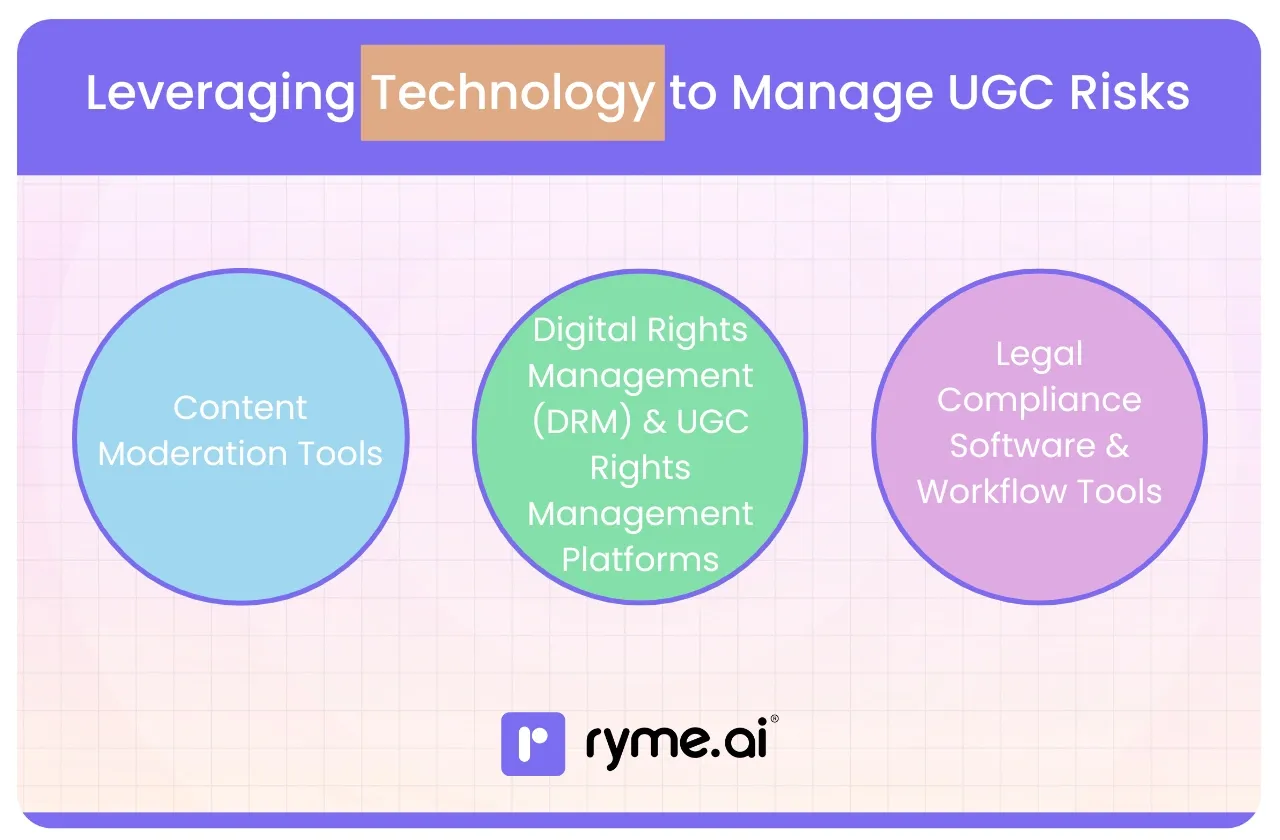
1) Content Moderation Tools: Your Digital Gatekeepers 🛡️
When you're encouraging users to share content with a specific hashtag or on your platform, you want to make sure the content that surfaces is appropriate, on-brand, and doesn't inadvertently expose you to legal issues.
What they are: Content moderation tools use a combination of Artificial Intelligence (AI) and sometimes human oversight to automatically scan, filter, and flag UGC based on predefined criteria.
How they help manage risks:
- Detecting Inappropriate Content: AI algorithms can be trained to identify and flag:
- NSFW (Not Safe For Work) content: Nudity, violence, gore.
- Hate speech and offensive language: Profanity, discriminatory remarks.
- Spam or irrelevant content: Users trying to hijack your hashtag.
- Spotting Potential Copyright/Trademark Infringement: Some advanced tools can detect visible logos of other brands (which you might not want in your UGC, or might need permission for), or even compare images against databases of copyrighted material (though this is more complex).
- Filtering out Personal Identifiable Information (PII): Some systems can be configured to flag content that appears to contain sensitive PII like phone numbers or email addresses, helping you avoid privacy breaches.
- Ensuring Brand Safety: They help ensure that the UGC associated with your brand aligns with your values and doesn't inadvertently tarnish your image.
How they work (generally):
- You set up rules and filters (e.g., keyword blacklists, image recognition parameters).
- UGC is fed into the system (e.g., by monitoring a hashtag, or through direct uploads).
- The AI analyzes the content. It might automatically approve, reject, or send content to a human moderator for review if it's unsure.
Examples of what they can do:
- Let's say you're a family-friendly toy brand running a UGC contest. A moderation tool could automatically filter out any submissions containing swear words or violent imagery.
- If you're a food brand, it could help filter out images that don't actually feature food, or that show competitor products prominently.
Benefit: Saves a HUGE amount of time and manual effort, provides a first line of defense, and allows your team to focus on the best, approved content. It also helps maintain consistency in your moderation standards. A 2023 report on AI in marketing highlighted that businesses using AI for content moderation saw up to a 60% reduction in the time spent on manual review processes.
2) Digital Rights Management (DRM) & UGC Rights Management Platforms: Keeping Permissions Straight 🔑
This is less about "DRM" in the traditional sense of locking down content (which is more for protecting your own original copyrighted assets), and more about platforms that help you manage the rights you've acquired to use UGC.
- What they are (in the UGC context): These are often integrated features within broader UGC marketing platforms. They provide a centralized system to:
- Request permissions: Some platforms automate sending out permission requests via social media comments or DMs.
- Track consent: They record when and how a user granted permission (e.g., by replying with a specific hashtag or clicking an approval link).
- Store creator information and usage rights: Who created it, what platforms you can use it on, for how long, and any other conditions of use.
- Manage a library of approved UGC: So your team knows which assets are cleared for use.
How they help manage risks:
- Clear Audit Trail: Provides documented proof of consent, which is invaluable if a dispute ever arises. This directly tackles copyright and privacy concerns.
- Prevents Accidental Misuse: If a piece of UGC is only cleared for Instagram, the system can help prevent it from being mistakenly used in an email campaign or on a billboard.
- Manages Expiry of Rights: If you only have rights to use content for a specific campaign duration, these platforms can help you track that and archive the content when rights expire.
- Centralized Control: Ensures everyone on your marketing team is working from the same set of approved assets and understands the usage limitations.
Example Scenario:
- Your team identifies 10 great Instagram posts from users featuring your new line of eco-friendly yoga mats.
- Using a UGC platform, you send out templated permission requests.
- Eight users reply with your approval hashtag (e.g., #YesYogaBrand). The platform logs these approvals automatically.
- These eight posts are now added to your "Approved UGC Library," tagged with "Social Media Use Only" and "Credit @UserHandle."
- Your social media manager can now confidently pull from this library for upcoming posts.
Benefit: Reduces the risk of human error in the permissions process, ensures compliance with the terms of consent, and makes managing a large volume of UGC much more organized and legally sound. It’s like having a super-organized digital librarian for your UGC! 📚
3) Legal Compliance Software & Workflow Tools: Staying on the Right Side of the Law ⚖️
While not always UGC-specific, broader legal tech and compliance software can support your UGC efforts.
What they are: These can range from tools that help you manage your privacy policies and consent forms (relevant for DPDPA/GDPR) to workflow platforms that ensure legal review steps are integrated into your marketing campaign processes.
How they help manage risks:
- Ensuring Up-to-Date Legal Documentation: Helping you create and maintain clear T&Cs for UGC campaigns, privacy notices explaining how you handle UGC data, and consent language that meets current legal standards (e.g., DPDPA in India, GDPR in EU).
- Standardizing Processes: Implementing workflows that ensure, for example, no UGC campaign goes live without legal team review of the T&Cs, or that permissions are always logged in a central system before content is used.
- Training and Awareness: Some platforms offer modules or resources to help train your marketing team on legal best practices related to UGC, copyright, and privacy.
- Managing Data Subject Requests (DSRs): If a user (a "data subject") wants to exercise their rights under DPDPA or GDPR (e.g., request deletion of their UGC you've featured), compliance software can help you manage and document these requests.
- Example: A legal compliance platform might provide templates for DPDPA-compliant consent notices that you adapt for your UGC permission requests. It could also help you track and respond to a user's request to have their photo removed from your website.
- Benefit: Helps to embed legal and compliance thinking into your UGC strategy from the ground up, rather than as an afterthought. It promotes a culture of compliance within your team.
A Word on Cost and Scalability:
Many of these tools, especially comprehensive UGC platforms with rights management and moderation, come with a subscription cost (often in USD, so consider the conversion to ₹). For small businesses or startups, this might seem like an added expense.
However, consider the potential cost of not using them:
- A copyright infringement lawsuit could cost lakhs or even crores of rupees.
- A data breach under DPDPA could lead to penalties up to ₹250 crore.
- The damage to your brand's reputation from a legal misstep can be immeasurable.
Start small if needed. Even if you can't afford a full-suite platform, implement robust manual processes for permission and tracking. As your UGC efforts scale, investing in the right technology becomes increasingly valuable and can save you significant headaches (and money!) in the long run.
Think of these technologies not as a replacement for understanding the legal principles, but as powerful allies that help you implement those principles effectively and efficiently. They empower you to focus on the creative and community-building aspects of UGC, with greater peace of mind. Go tech! 🚀
Conclusion
User-Generated Content (UGC) can significantly boost brand authenticity and engagement by leveraging customers' real experiences shared in their content. While cost-effective, it requires navigating legal aspects like copyright, privacy, defamation, and platform terms with respect and fairness.
Key practices include always asking for explicit permission, providing clear campaign guidelines, respecting privacy, properly crediting creators, and monitoring content for compliance, considering regional laws like those in the US, EU, and India (DPDPA and IT Rules).
Tools for moderation and rights management simplify this. UGC is a powerful marketing strategy built on collaboration, respect, and understanding the rules, making customers feel valued and part of the brand story. Encourage sharing and showcase customer brilliance responsibly.
Actionable Checklist & Key Takeaways for Your UGC Strategy 🚀
Feeling ready to rock your UGC game? Here’s a quick checklist to keep you on track:
UGC Foundations:
✅ Define Your Goals: What do you want to achieve with UGC? (e.g., increase engagement, build trust, gather testimonials, drive sales).
✅ Identify Your Target UGC: What kind of content are you looking for? (e.g., photos with product, video reviews, creative uses).
✅ Choose Your Platforms: Where will you solicit and feature UGC? (e.g., Instagram, Facebook, Twitter, your website).
The Golden Rules of Permission & Rights:
✅ ALWAYS Get Explicit Permission: Before using any UGC, reach out and get a clear "yes" (preferably written, like a DM reply with a specific hashtag).
✅ Specify Usage: Be clear about how and where you plan to use their content.
✅ Keep Records of Consent: Screenshot DMs, save emails. This is your proof!
✅ Credit Creators Properly: Tag them in the image/video AND mention them in the caption. Acknowledge their work!
Campaign & Content Guidelines:
✅ Develop Clear Campaign Guidelines (if applicable): Theme, do's & don'ts, hashtags, deadlines. Link to full T&Cs.
✅ Communicate T&Cs Clearly: Make them easily accessible (link in bio, website). Ensure they cover usage rights.
Legal & Ethical Checks:
✅ Respect Privacy: Scrutinize content for sensitive PII before sharing. Don't share private DMs publicly without consent.
✅ Understand Copyright Basics: The creator owns the copyright. You need their permission to use it.
✅ Avoid Defamation: Don't share false statements that could harm another's reputation.
✅ Comply with Platform Terms: Know the rules of Instagram, Facebook, etc., for promotions and content.
✅ Stay Updated on Data Protection Laws: Especially India's DPDPA, 2023 (consent is key for personal data like images).
✅ Monitor Regularly: Keep an eye on UGC shared with your brand for appropriateness and compliance. Have a plan to address problematic content.
Leveraging Technology (Consider as you scale):
✅ Explore Content Moderation Tools: To filter inappropriate content automatically.
✅ Look into UGC Rights Management Platforms: To streamline permission requests and track consent.
✅ Consider Legal Compliance Software: For managing T&Cs, privacy policies, and consent workflows.
